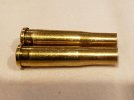So I finally got out with a 22 Hornet that I recently purchased. It is a Kimber or Oregon Model 82. I looks like new, not a mark on it. I would love to have reloaded for it, but did not have brass. I did find a store with 22 Hornet loaded ammo though. They had 3 different loads available, a Remington 50 round box for $53.99, a Winchester 50 round box for $50.99, and a Hornady 25 round for $20.99. I bought the 3 boxes they had of the Hornady. They were all the same batch. I took them out shooting. I initially shot them at 25 yards, just to get them on paper and was going to shoot them afterwards at 100 yards. I got to right where I wanted them by the ninth round, but the ninth round separated the case (should be the first photo). I didn't have a way of removing the upper end of the casing from the chamber since I did not bring a cleaning rod with me. Once I got home, I used a .224 copper brush and remove it. I phoned Hornady and spoke to a guy in Tech Support and he asked me to look at other rounds that I fired and see if any looked odd of that group. They all seemed to have rings around them (see second photo). He said that the batch I got was from 2015, but they had no complaints about that batch. The measured the rim of the 22 hornet cartridge and it looked like it was 0.065" thick, which, since it is a rimmed cartridge, then that is what determines headspace. In looking at the dimensions of the cartridge, there is nothing glaring wrong.
Please, I am digging into this, so if I make any incorrect comments or assumptions, correct me.
In measuring the shot cartridge and the unfired cartridge, this is what I found. Please note that in measuring the distance from the rear of the cartridge to where the shoulder begins and ends, it is such a small angle change, that it is difficult to get the exact measurement.
Item measured Factory Ammo Fired round Hornady reloading manual says it should be
Rim thickness 0.065" 0.065" 0.065"
Diameter just above 0.292" 0.296" 0.299"
the rim (note that the fired round starts at 0.293" and jumps to 0.299".
Distance from base to 0.871" 0.867" 0.853"
shoulder starting
Distance from base to 1.043" 1.010" 1.017"
shoulder ending
Diameter just before 0.276" 0.281" 0.278"
the shoulder
Diameter just beyond 0.241" 0.249" 0.244"
the shoulder
Case length 1.393" 1.404" 1.403"
I wondered if the shoulder is too far forward in chamber and that in firing the cartridge, the cartridge stretches enough that it separates. Thoughts? Am I even barking up the right tree?
Please, I am digging into this, so if I make any incorrect comments or assumptions, correct me.
In measuring the shot cartridge and the unfired cartridge, this is what I found. Please note that in measuring the distance from the rear of the cartridge to where the shoulder begins and ends, it is such a small angle change, that it is difficult to get the exact measurement.
Item measured Factory Ammo Fired round Hornady reloading manual says it should be
Rim thickness 0.065" 0.065" 0.065"
Diameter just above 0.292" 0.296" 0.299"
the rim (note that the fired round starts at 0.293" and jumps to 0.299".
Distance from base to 0.871" 0.867" 0.853"
shoulder starting
Distance from base to 1.043" 1.010" 1.017"
shoulder ending
Diameter just before 0.276" 0.281" 0.278"
the shoulder
Diameter just beyond 0.241" 0.249" 0.244"
the shoulder
Case length 1.393" 1.404" 1.403"
I wondered if the shoulder is too far forward in chamber and that in firing the cartridge, the cartridge stretches enough that it separates. Thoughts? Am I even barking up the right tree?



